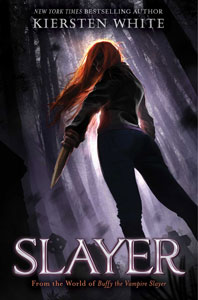In 2008 when the “Buffy” book line was canceled, author Yvonne Navarro lamented to SlayerLit: “Dangling out there is a golden opportunity based on the final show in the series … an unlimited number of tales about Slayers from all over the world, doing what they do best in their own environment but under the Buffyverse rules. Let the book line grow beyond Sunnydale or Los Angeles. The whole world awaits!”
Better late than never, Kiersten White’s 401-page young-adult novel “Slayer” (January, hardcover) fulfills Navarro’s prophecy (so to speak). It’s the first “Buffy” novel in 11 years, the first full-length novel about a new Slayer (there were a lot of “Tales of the Slayer” novellas and short stories back in the day), and the first book about one of those thousands of post-“Buffy Shares Her Powers” girls. It’s also the first story that chronicles one of those Slayers without being in Buffy’s sphere of influence; in the comics, those Slayers are connected to Buffy’s story in some way.
Discounting the fact that “Slayer” was snuck onto store shelves without a “Buffy” logo on the cover, White had a mountain of expectations to fulfill once fans found this book. Remarkably, she checks the boxes of what makes a good Buffyverse story while writing something that’s comparable to no previous novel.
Granted, it’s not a perfectly constructed work. Notably, titular Slayer Nina Jamison-Smythe does a lot of whining about how she hates Buffy because she got her father — Buffy’s first Watcher, Merrick — killed. It’s like “OK, we get it already. Nina hates Buffy.” This attitude trickles down from Nina’s mom, Helen, since Nina was a baby at the time of “The Origin.” In “Slayer,” she’s 16 and the book is set soon after the destruction of the Seed in Season 8. So she’s old enough to remember the First’s destruction of the Watchers’ Council HQ (in Season 7), which she also manages to blame on Buffy.
Told from a first-person perspective, “Slayer” is overwritten in some ways; in addition to the “I hate Buffy” stuff, Nina – who lives with the remnants of the Watchers’ Council in a hidden castle in an Irish forest — comes back to several mysteries a lot, without enough forward momentum each time she mulls them. That said, the mysteries are juicy. Does her newly assigned Watcher, 19-year-old Leo, like her, or still see her as a child? Why and how did her intelligent twin sister, Artemis, fail the Watcher’s entry exam? What creature is killing Slayers in Dublin? What’s with the prophecy in Merrick’s journals about a girl who will destroy the world and a twin who will save it?
Aside from the facts that Nina is Merrick’s daughter and that she chats with Buffy in shared Slayer dreams later in the book, “Slayer” doesn’t lean on the established Buffyverse all that much – which is perhaps a good thing. White clearly knows the rules of the Buffyverse, but this doesn’t feel like any other story.

Part of it is the writing style: With the story to be continued in future books, this marks a robust coming-of-age journey for Nina, the “Last Slayer” (she’s activated just before the Seed of Wonder is destroyed). She doesn’t quip like the Scooby Gang. Sometimes she trips over her words or awkwardly constructs sentences when she’s flustered, but Nina is her own person. Although she wouldn’t have become a Slayer without Buffy and Willow’s action, she’s not influenced by Buffy beyond that.
Interestingly, she comes from a strong legacy but it doesn’t shape her in the ways you would assume. Merrick served as the Watcher for two Slayers prior to Buffy; he clearly was well-regarded by the Council. Helen is also a Watcher, and we learn something about her background that ties her more closely to Slayer lore. Yet this is not the standard “raised to be royalty” yarn. Nina is not groomed as a Potential; in fact, she is encouraged to go into the field of medicine while her sister receives physical training. Although they are twins, Artemis has the role as the “older” sister, Nina’s protector.
Another thing that makes “Slayer” different is the plotting. This can’t be on the epic scale of the Dark Horse comics; it has to be small enough that – while it’s huge to Nina – Buffy and the other major players of Season 9 and beyond know nothing about it. So the threats include a hellhound (the creatures Buffy fairly easily dispatches in “The Prom”) bursting onto the castle grounds. Italicized interludes show the POV of what might be the villain, but since this is a mostly first-person novel, we don’t get the grand passages about the bad guy’s plan that are staples of the 1997-2008 books.
And I like how – despite connections to families we know, such as the Wyndam-Price line – these new characters are not exact parallels to the Scooby Gang or Angel Investigations. In addition to Artemis, Nina’s contemporaries are the bookish Rhys; Rhys’ boyfriend Cillian, who lives on the outskirts of the forest; Artemis’ girlfriend Honora, who is a bully; Imogen, who takes care of the “Littles” (the young kids in the castle); Jade, who we don’t get to know that well; and Leo, the young Watcher and Nina’s crush. The older Watchers also have personalities. In that way, there’s a slight Hogwarts vibe, but without the vibrancy of a functioning school; these people are living a stark, sheltered life in hiding.
White gives us a strong entry point to this series about Nina. Some tricky tasks lie ahead, including the ongoing fact that Buffy and company don’t reference Nina in Seasons 9-12. So how big can the stories get? But this is a good start, and – now that Nina the Vampire Slayer can stand on her own — I think the series could get even better if it peppers in more connections to the wider lore (including more insight into Merrick’s first two Slayers, perhaps?).
Click here for an index of all of John’s “Buffy” and “Angel” reviews.

